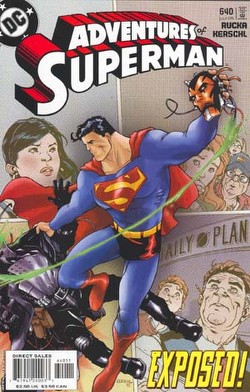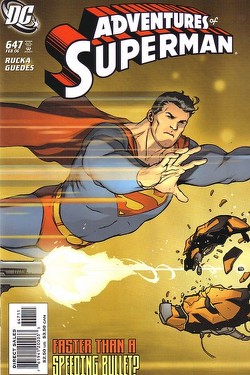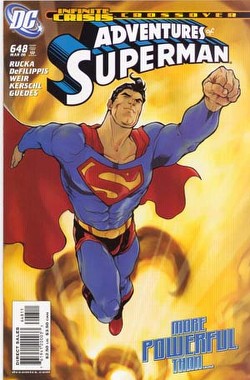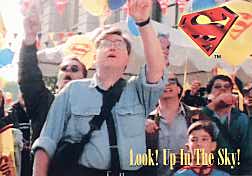Interviews
Exclusive Karl Kerschl Interview
[Date: April 2008]By Jason Larouche.
Karl Kerschl is an artist who has worked on many Superman comics over the years.
Superman Homepage writer Jason Larouche interviewed Karl about his career, his work on the Superman comic books, and more.
The Superman Homepage would like to thank Karl for agreeing to do this interview, and for fitting it into his busy schedule.
 Q: At what point in your life did you develop an interest in art?
Q: At what point in your life did you develop an interest in art?Karl: I don't remember. I was three or four years old. I've been drawing as long as I can remember. I used to draw little dinosaurs and comic book characters and eventually I reached a point around early high school where I wasn't drawing at all. And basically picked it up again when I became interested in comic books.
Q: Did you read any comic books as a kid? If so, which ones?
Karl: When I was younger I read a lot of --- I read Elfquest actually; I was a big fan of that. I read a lot of Tin Tin. Actually I read a lot of syndicated comic strips like Garfield [but] later on I became more interested in [books like] X-Men and Superman and stuff, mainly because I was following different artists and stuff.
Q: Can you name your creative influences?
Karl: Well, Bill Waterson, Harry J, Moebius, Mike Mignola, Kevin Nowlan, Bill Sienkevitz - a big influence on me - Frank Miller... Those are some of the bigger ones.
Q: Did you receive any formal education or training or is most of your skill self-taught?
Karl: Mostly self-taught. I went to school for a year after high school [for] visual arts at the University of Windsor, but I didn't finish there. It was more fine arts-related and I [was] more interested in pursuing illustration, so I left that program. I pretty much taught myself.
Q: What was your first professional assignment and what did you take with you from that experience?
Karl: My first professional assignment was a cover of Green Hornet for Now Comics many many years ago, for which I was never paid. I did three covers and they never paid me. The company folded.
Q: That sucks.
Karl: Yes it does suck (laughs).
 Q: Can you recall the first Superman project you pencilled?
Q: Can you recall the first Superman project you pencilled?
Karl: Yeah, I did... I can't remember which one but it was one of the Return to Krypton books and then later on I had a regular stint on Adventures of Superman with Greg Rucka.
Q: When handling a character like Superman, whose only means of disguise are a change of hair style and glasses, can you describe any tricks in order to make the two distinct? And in your opinion, why does the disguise work so well?
Karl: I guess the only thing you do is really play with facial expressions and body postures. In a lot of my run, there wasn't much distinction between Clark Kent and Superman physically because Clark was depicted as a fairly competent reporter; he wasn't nerdy or goofy-looking. I didn't really spend a lot of time figuring out how to make these two personas distinct. I know I parted his hair on different sides, but I think what Frank Quitely is doing on All-Star Superman now is really a lot more effective. He actually gives Clark a slump, has his hair bedraggled, give him a kind of double chin. I think that's extremely effective and if I were to do it again, I'd follow that lead.
Q: In your opinion why does this disguise work so well?
Karl: Suspension of disbelief.
Q: Superman, the first and greatest of all heroes, has become a staple for any comic creator to look to for inspiration when creating an original work from both a visual and literary standpoint. Now seventy years old and still going strong, why do you think the character has endured for so long?
Karl: He endures because is a really strong archetype for humanity and heroism in general. I think - I've mentioned this so many times I'm at a loss for words here - I think that the character feels, after being around for so long, more human, more real, than many other fictional characters. And he's in the human subconscious so much that people just accept him as another person in a way. I know I do. That's part of the reason why he endures, at least in my mind. That's why I keep coming back to that character.
Q: The Siegels recently acquired equal share of the rights to the Superman property. Do you feel the result of this dispute, which encompasses the fate of the Connor Kent character as well as the ongoing debate over Smallville's inspiration, is positive or negative?
 Karl: I think if any rights revert back to the original creators, I think that's a very positive thing. If that happened to Superman, the Siegel and Shuster estates get reimbursed for their creation, that's nothing but a good thing.
Karl: I think if any rights revert back to the original creators, I think that's a very positive thing. If that happened to Superman, the Siegel and Shuster estates get reimbursed for their creation, that's nothing but a good thing.
Q: With the socio-cultural fascination with comic book lore at its highest via television and cinema, what do you believe the direct cause is?
Karl: I think we've all wanted to see these characters come to life. It's just that the technology has caught up with them now. And you're able to get accurate depictions of these things on the big screen. Things they couldn't do realistically before. And I think that there's a lot of unbounded creativity going on in comic books and people in Hollywood are starting to discover that they can mine that maybe because they're running out of ideas.
Q: Stan Lee once said the villains are more difficult to create and sustain than the heroes. Do you believe this to be true and if so why?
Karl: Well I don't know if it's more difficult. I think to create a good villain you have to first create a believable person as a character. You can't depict someone as an outright villain; you have to have some sort of motivation for their misdeeds. So, I guess it's more difficult to make that believable, yeah.
Q: With so many Superman-related projects in the works - the movie sequel, Smallville's eigth and final season, and his upcoming role in the Final Crisis - which are you anxious to see?
Karl: I'm definitely interested in a sequel to the film if Bryan Singer is directing it. I'd love to see what he does that's his own after Superman Returns. While I enjoyed it, it was reverential to the original Donner material. I think Singer's probably got his own story in him somewhere that's a bit of a departure from that. I'd like to see what he does.
This interview is Copyright © 2008 by Steven Younis. It is not to be reproduced in part or as a whole without the express permission of the author.
Interviews
Introduction
The Superman Homepage has had the pleasure of interviewing various Superman Comic Book creative people about their work.
Question and Answer Interviews:
- Interview with writer Marv Wolfman about Man and Superman: The Deluxe Edition (November 2019)
- Interview with artist Claudio Castellini about Man and Superman: The Deluxe Edition (November 2019)
- Interview with artist Joe Staton about working on Superman properties over the years (November 2019)
- Interview with Christopher Priest about the Superman vs. Deathstroke story in Deathstroke #8 (November 2016)
- Interview with Sterling Gates about the 'Adventures of Supergirl' digital-first comic book series (January 2016)
- Interview with J. Michael Straczynski about “Superman: Earth One - Vol. 3” - Writer J. Michael Straczynski talks to us about the third volume in the “Superman: Earth One” graphic novel series (February 2015)
- Interview with Jim Krueger - Writer Jim Krueger talks to us about his “The Dark Lantern” story in the “Adventures of Superman” comic book title (November 2013)
- “Smallville: Season 11” Interview with Bryan Q. Miller - Writer Bryan Q. Miller talks to us about his work on the “Smallville: Season 11” comic book title (October 2012)
- “Supergirl” Interview with Mahmud Asrar - Artist Mahmud Asrar talks to us about his work on the monthly “Supergirl” comic book title (July 2012)
- “Superman/Batman” Interview with Joshua Hale Fialkov - Joshua Hale Fialkov answers our questions about “The Secret” 3-part story in “Superman/Batman” #85-87 (July 2011)
- “Supergirl” Interview with Sterling Gates - Sterling Gates answers our questions about where Supergirl is headed post “War of the Supermen” (June 2010)
- “Supergirl” Interview with Sterling Gates & Jamal Igle - Adam Dechanel chats with the “Supergirl” comic book team about the Maid of Might (March 2010)
- Behind the Scenes of the Super Friends - Four part indepth look at the “Super Friends” comic book title with artists J. Bone and Stewart McKenny (February 2010)
- Interview with Landry Q Walker and Eric Jones - The writer and artist discuss Supergirl: Cosmic Adventures in the Eighth Grade (May 2009)
- Interview with Elliot S! Maggin - Legendary Superman writer and novelist discusses his career (January 2009)
- Interview with J. Bone - Artist discusses Super Friends comic book (November 2008)
- Interview with Mark Bagley (September 2008)
- Interview with J. Torres - Writer discusses Legion of Super Heroes in the 31st Century #18 (September 2008)
- Interview with Jake Black (May 2008)
- Interview with Cary Bates (June 2008)
- Interview with Jack Briglio - Writer discusses Legion of Super Heroes in the 31st Century #14 (May 2008)
- Interview with Ken Pontac - Writer discusses Justice League Unlimited #44 (May 2008)
- Interview with Karl Kerschl (April 2008)
- Interview with J. Torres - Writer discusses Legion of Super Heroes in the 31st Century #13 (April 2008)
- Interview with J. Torres - Writer discusses Legion of Super Heroes in the 31st Century #11 (February 2008)
- Interview with Fabian Nicieza - Writer on Superman comic books (June 2007)
- Interview with Danny Fingeroth - Writer of the book Superman on the Couch (May 2007)
- Interview with Jesse McCann - Writer on the Krypto The Superdog comic books (December 2006)
- Interview with Matt Haley - Artist on the Superman Returns comic book movie adaptation (November 2006)
- Interview with Ethan Van Sciver - Artist on Superman/Batman (September 2006)
- Interview with Mark Verheiden on taking over the writing duties on Superman/Batman (April 2006)
- Interview with Matt Idelson on taking over as Superman group editor (March 2006)
- Interview with Jeph Loeb on Sam and “Superman/Batman #26” (February 2006)
- Interview with Roger Stern (December 2005)
- Interview with Marv Wolfman (November 2005)
- Interview with Gail Simone (May 2005)
- Interview with Greg Rucka (April 2005)
- Interview with Brad Meltzer [Identity Crisis] (January 2005)
- Interview with Glenn Whitmore (November 2004)
- Interview with Jeph Loeb (September 2004)
- Interview with Karl Kerschl (September 2004)
- Interview with Ron Garney (September 2004)
- Interview with Greg Rucka and Matthew Clark (May 2004)
- Interview with Ed McGuinness (March 2004)
- Interview with Brad Meltzer [Identity Crisis] (March 2004)
- Interview with Mark Millar [Superman: Red Son] (March 2003)
- Interview with Min S. Ku (September 2001)
- Interview with Jeph Loeb (May 2001)
- Interview with Joe Casey (April 2001)
- Interview with Mike S. Miller (September 2000)
- Interview with Denis Rodier (August 2000)
- Interview with Grant Morrison (December 1999)
- Interview with Mark Millar [Part 2] (November 1999)
- Interview with Mark Millar [Part 1] (April 1999)
Interviews/Articles:
- “Superman vs. Terminator” - A Chat with Fight Promoter Alan Grant. (January 2000)
- Superman: The Dailies (1939-1940) Graphic Novel Review.
- The Rebirth of Superman (Part 1) - Superman is reborn... again.
- The Rebirth of Superman (Part 2) - Eddie Barganza on taking the character in a new direction.
- The Rebirth of Superman (Part 3) - Jeph Loeb discusses writing the Man of Steel.
- Lex Luthor For President - Forget Superman. An updated Luthor's new enemies are Gore and Bush.
- Superman: Last Son of Earth - Steve Gerbern Interview - The writer discusses flip-flopping the Man of Steel's origin. (August 2000)
Krypton Club Interviews:
 When “Lois & Clark” started production in 1993, there was an obvious relationship between the comic book people and the Hollywood people.
When “Lois & Clark” started production in 1993, there was an obvious relationship between the comic book people and the Hollywood people.
A trade paperback “Lois and Clark: The New Adventures of Superman”, was published, with Dean Cain and Teri Hatcher on the cover. It included reprints of comic book stories that were the inspiration for “Lois & Clark”, helping to define the characters. Comic's included are: The Story of the Century (Man of Steel miniseries #2), Tears for Titano (Superman Annual #1), Metropolis - 900 mi (in SUP #9), The Name Game (SUP #11), Lois Lane (in ACT #600), Headhunter (AOS #445), Homeless for the Holidays (AOS #462), The Limits of Power (AOS #466), and Survival (ACT #665).
A number of comic book writers and artists had roles as extras in the episode “I'm Looking Through You” (Season one, episode 4). Their presence was immortilized in the Sky Trading Card #34.
Craig Byrne, president of the online “Lois & Clark” fanclub The Krypton Club, carried out a series of interviews with comic book writers. The interviews are reprinted with permission of the Krypton Club.
- Interview with Roger Stern (June 1995)
- Interview with John Byrne (June 1995)
- Interview with Mike Carlin (July 1995)
